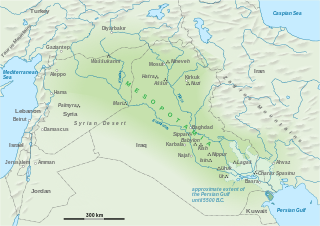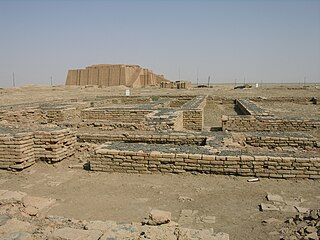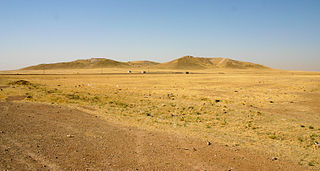Giorgio Buccellati is an Italian archaeologist, best known for having discovered the ancient city of Urkesh (modern Tell Mozan), capital of the Hurrians, in Syria.
Giorgio Buccellati is an Italian archaeologist, best known for having discovered the ancient city of Urkesh (modern Tell Mozan), capital of the Hurrians, in Syria.
Buccellati is a Professor Emeritus in the Department of Near Eastern Languages and Cultures [1] and the Department of History at UCLA. [2] He was the founding director of the Cotsen Institute of Archaeology. [3] He founded IIMAS – The International Institute for Mesopotamian Area Studies, [4] of which he is currently the Director. He has also been active as a publisher, having founded Undena Publications, [5] of which he is currently the General Editor.

Buccellati has published extensively in the fields of Akkadian philology, linguistics and literature; cuneiform graphemics; history of Mesopotamian political institutions and religion; archaeology of Syria; digital systems applied to Mesopotamia. He has participated and directed archaeological projects in Iraq, Turkey, the Caucasus and especially Syria (Terqa, Urkesh).
Buccellati is a scholar of ancient Syro-Mesopotamia, engaged in research in the fields of language, history and archaeology, he is particularly conscious of the need of introducing perspectives and views that help us to better understand an ancient world which, despite far in time, is yet fundamental for our modern sensitivity. Thus, for instance, his A Structural Grammar of Babylonian highlighted some details of this language seen not as "dead" but as alive in its organic structure still fully accessible in all its nuances. He was the first to introduce the use of computers in the field of archaeology in Syria, and he is at the forefront of using digital methods that are transforming our way of deeply understanding the world of ancient material culture. His historical research led him to review the keys of interpretation and understanding of both the institutional and spiritual development of the ancient Mesopotamians, in particular the origins of politics and the growth of the State, impact of ethnic factors in the structuring of new groups like the tribe, the possibility of accessing the perceptive world through research mechanisms based on the canons of objectivity.
Buccellati is a full professor in the two departments of languages and history at the University of California at Los Angeles (UCLA), he founded the Institute of Archaeology in 1973 (Cotsen Institute of Archaeology), which he supervised as the first director until 1983. Currently "Emeritus", he continues teaching and is "Research Professor" and director of the Mesopotamian archaeology laboratory at the same institute. He is co-director of the research project "Philosophical Dimensions of the Hermeneutics of Archeology" within the Department of Philosophy of the "Università Cattolica del Sacro Cuore", Milan. In 1973 he founded IIMAS – "The International Institute for Mesopotamian Area Studies", and in 2010 his Italian counterpart, the "Istituto Internazionale per la Mesopotamia e l’Alta Siria", of which he is still the director.
Author of a dozen volumes and more than one hundred scientific papers, "Guggenheim Fellow" for his ethnographic and geographical research in Syria, he is currently involved in the creation of a large website (URG – “Urkesh Global Record”) which develops in a completely innovative way a fully digital approach to archaeological data, through a humanistic and scientific perspective.
With his wife Marilyn Kelly-Buccellati, Professor Emerita of California State University, Los Angeles, he has conducted archaeological excavations and surveys in Iraq, Turkey, the Caucasus and especially in Syria. It is here where, for twenty-five years, they have jointly directed the excavations of the ancient city of Urkesh/Tell Mozan, where they have involved a large international team. They also work together in publishing excavation reports and interpreting archaeological data and have given countless scientific lectures in the world's major archaeological institutions.
In 2021, he was awarded the Balzan Prize for Art and Archaeology of the Ancient Near East together with his wife Marilyn Kelly-Buccellati.

After completing his classical studies at the Gonzaga Institute in Milan, he graduated in ancient history at the Università Cattolica del Sacro Cuore", Milan in 1959; he then completed his studies in philosophy at Fordham University in New York in 1961 and oriental civilizations at the University of Chicago in 1965. He then taught at the University of California at Los Angeles (UCLA), where, in 1973, he founded the Cotsen Institute of Archeology directing it for the next ten years and where, since 1994, he has been professor emeritus in the two departments of languages and history. In 1973 he also founded the IIMAS (The International Institute for Mesopotamian Area Studies). Also active in the publishing field, he established Undena Publications whose he is the general director.
His in-depth research and related publications concern the Akkadian world (philology, linguistics, and literature), cuneiform graphematics, the history of the political and religious institutions of Mesopotamia and the archaeology of Syria. With his wife Marilyn Kelly-Buccellati he has participated in and directed archaeological projects in Iraq (in Nippur and Dilbat), in Turkey (at Korucutepe), in the Caucasus and especially in Syria (in Terqa and Urkesh/Tell Mozan). Besides having created important scientific websites, [6] since 1968 he has applied digital systems to archaeological and linguistic research.

The Akkadian Empire was the first ancient empire of Mesopotamia after the long-lived civilization of Sumer. It was centered in the city of Akkad and its surrounding region. The empire united Akkadian and Sumerian speakers under one rule. The Akkadian Empire exercised influence across Mesopotamia, the Levant, and Anatolia, sending military expeditions as far south as Dilmun and Magan in the Arabian Peninsula.

Mesopotamia is a historical region of Western Asia situated within the Tigris–Euphrates river system, in the northern part of the Fertile Crescent. Mesopotamia occupies modern Iraq. The historical region includes also the head of the Persian Gulf and southeast Turkey, west Iran, northeastern Syria and northern Kuwait.

Ur was an important Sumerian city-state in ancient Mesopotamia, located at the site of modern "Tell el-Muqayyar" in south Iraq's Dhi Qar Governorate. Although Ur was once a coastal city near the mouth of the Euphrates on the Persian Gulf, the coastline has shifted and the city is now well inland, on the south bank of the Euphrates, 16 kilometres from Nasiriyah in modern-day Iraq. The city dates from the Ubaid period circa 3800 BC, and is recorded in written history as a city-state from the 26th century BC, its first recorded king being Mesannepada.

The Hurrians were a people of the Bronze Age Near East. They spoke a Hurro-Urartian language called Hurrian and lived in Anatolia, Syria and Northern Mesopotamia. The largest and most influential Hurrian nation was the kingdom of Mitanni, its ruling class perhaps being Indo-Iranian speakers. The population of the Indo-European-speaking Hittite Empire in Anatolia included a large population of Hurrians, and there is significant Hurrian influence in Hittite mythology. By the Early Iron Age, the Hurrians had been assimilated with other peoples. Their remnants were subdued by a related people that formed the state of Urartu. The present-day Armenians are an amalgam of the Indo-European groups with the Hurrians and Urartians.

Nippur was an ancient Sumerian city. It was the special seat of the worship of the Sumerian god Enlil, the "Lord Wind", ruler of the cosmos, subject to An alone. Nippur was located in modern Nuffar in Afak, Al-Qādisiyyah Governorate, Iraq. Occupation at the site extended back to the Uruk, Ubaid, and Jemdat Nasr Periods.
Assyriology is the archaeological, historical, and linguistic study of Assyria and the rest of ancient Mesopotamia and of the related cultures that used cuneiform writing. The field covers Sumer, the early Sumero-Akkadian city-states, the Akkadian Empire, Ebla, the Akkadian and Imperial Aramaic speaking states of Assyria, Babylonia and the Sealand Dynasty, the migrant foreign dynasties of southern Mesopotamia, including the Gutians, Amorites, Kassites, Arameans, Suteans and Chaldeans, and to some degree post-imperial Achaemenid Assyria, Athura, Eber-Nari, Assyria, and Assuristan, together with later Neo-Assyrian states such as Adiabene, Osroene, Hatra, Beth Nuhadra and Beth Garmai, until the Arab invasion and Islamic conquest of the mid-7th century AD. Some Assyriologists also write on the further Assyrian continuity of the Assyrian people as well as the Mandaeans to the present.

Urkesh or Urkish is a tell, or settlement mound, located in the foothills of the Taurus Mountains in Al-Hasakah Governorate, northeastern Syria. It was founded during the fourth millennium BC possibly by the Hurrians on a site which appears to have been inhabited previously for a few centuries.

Naram-Sin also transcribed Narām-Sîn or Naram-Suen, was a ruler of the Akkadian Empire, who reigned c. 2254–2218 BC, and was the third successor and grandson of King Sargon of Akkad. Under Naram-Sin the empire reached its maximum strength. He was the first Mesopotamian king known to have claimed divinity for himself, taking the title "God of Akkad", and the first to claim the title "King of the Four Quarters, King of the Universe".

Tell Brak was an ancient city in Syria; its remains constitute a tell located in the Upper Khabur region, near the modern village of Tell Brak, 50 kilometers north-east of Al-Hasaka city, Al-Hasakah Governorate. The city's original name is unknown. During the second half of the third millennium BC, the city was known as Nagar and later on, Nawar.

The Early Dynastic period is an archaeological culture in Mesopotamia that is generally dated to c. 2900–2350 BC and was preceded by the Uruk and Jemdet Nasr periods. It saw the development of writing and the formation of the first cities and states. The ED itself was characterized by the existence of multiple city-states: small states with a relatively simple structure that developed and solidified over time. This development ultimately led to the unification of much of Mesopotamia under the rule of Sargon, the first monarch of the Akkadian Empire. Despite this political fragmentation, the ED city-states shared a relatively homogeneous material culture. Sumerian cities such as Uruk, Ur, Lagash, Umma, and Nippur located in Lower Mesopotamia were very powerful and influential. To the north and west stretched states centered on cities such as Kish, Mari, Nagar, and Ebla.

Amuda is a town in Al Hasakah Governorate in northeastern Syria close to the Syria–Turkey border. As a result of the ongoing Syrian civil war, Amuda is currently under the civil control of the Autonomous Administration of North and East Syria and military control of the Syrian Democratic Forces and Syrian Army.

Terqa is the name of an ancient city discovered at the site of Tell Ashara on the banks of the middle Euphrates in Deir ez-Zor Governorate, Syria, approximately 80 kilometres (50 mi) from the modern border with Iraq and 64 kilometres (40 mi) north of the ancient site of Mari, Syria. Its name had become Sirqu by Neo-Assyrian times.

Ninkarrak was a goddess of medicine worshiped chiefly in Syria and northern Mesopotamia. It's assumed her origin is Akkadian or Syrian, rather than Sumerian. A particularly notable temple dedicated to her was unearthed in Terqa. Finds from its excavations are regarded as very significant in dating the history of the region.

The Hurrian songs are a collection of music inscribed in cuneiform on clay tablets excavated from the ancient Amorite-Canaanite city of Ugarit, a headland in northern Syria, which date to approximately 1400 BCE. One of these tablets, which is nearly complete, contains the Hurrian Hymn to Nikkal, making it the oldest surviving substantially complete work of notated music in the world. While the composers' names of some of the fragmentary pieces are known, h.6 is an anonymous work.

Tish-atal was endan of Urkesh during the Third Dynasty of Ur. He was one of the earliest known Hurrian rulers, but the archaeological record is fragmentary for this period, and no precise date can be ascribed to his reign.

The Hurrian foundation pegs, also known as the Urkish lions, are twin copper foundation pegs each in the shape of a lion that probably came from the ancient city of Urkesh in Syria. The pegs were placed at the foundation of the temple of Nergal in the city of Urkesh as mentioned in the cuneiform inscriptions on them. The inscription on the two pegs and the associated stone tablet is the oldest known text in the Hurrian language. One of the lions is now housed, along with its limestone tablet, in the Musée du Louvre in Paris. The second lion is on display at the Metropolitan Museum of Art in New York.

Two main types of seals were used in the Ancient Near East, the stamp seal and the cylinder seal. Stamp seals first appeared in ‘administrative’ contexts in central and northern Mesopotamia in the seventh millennium and were used exclusively until the fifth millennium. Cylinder seals appeared first around 3600 bc in southern Mesopotamia and south-western Iran. They gradually replaced stamp seals, becoming the tool of a rising class of bureaucrats in the early stages of state formation. Even though stamp seals were still produced in the third and second millennia, cylinder seals predominated. In the first millennium, stamp seals made a strong comeback and eventually replaced cylinder seals entirely.
Stephanie Mary Dalley FSA is a British scholar of the Ancient Near East. She has retired as a teaching Fellow from the Oriental Institute, Oxford. She is known for her publications of cuneiform texts and her investigation into the Hanging Gardens of Babylon, and her proposal that it was situated in Nineveh, and constructed during Sennacherib's rule.

Indus–Mesopotamia relations are thought to have developed during the second half of 3rd millennium BCE, until they came to a halt with the extinction of the Indus valley civilization after around 1900 BCE. Mesopotamia had already been an intermediary in the trade of lapis lazuli between South Asia and Egypt since at least about 3200 BCE, in the context of Egypt-Mesopotamia relations.
Marilyn Kelly-Buccellati is an American archaeologist, who focused her research on the Caucasus and ancient Syria in the third and second millennium B.C..